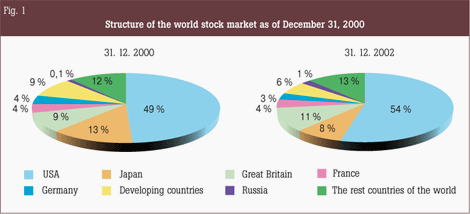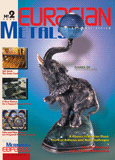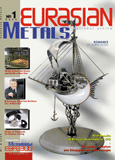Victor Bobylev
PhD in Economics
George Bobylev
Economist
AN IMPACT OF THE CRISIS IS STILL PERCEPTIBLE ON THE STOCK MARKET
Development of the world economy during the recent three years is characterized as depressive. After the recurring recession aggravated by the events of September 11, 2001, the rate of economic growth slowed down to 2–2.5 % of GDP to get even lower (1 to 2.5 % of GDP) in some industrial countries. In the first quarter of the year 2000 a crisis broke out on stock markets of these countries to continue until the second quarter of the year 2003. Over the last three years, which have passed since the collapse of hi-tech companies’ shares on the American stock market in February 2000, prices for them have decreased almost twice, with the total capitalization of the world stock market reducing from $ 40 trillion in 2000 down to $ 27 trillion in late 2002.
An aggregate capitalization of the US stock market decreased by 40 %, with NASDAQ index collapsing from 5,000 in February 2000 down to 1,300 in March 2003. Over the same period capitalization of the European companies went down by 30–40 %. The same situation was on the Japanese stock market, which suffered a 60 % decrease. At the same time the share of the Great Britain, Russia and some other developing countries (e.g. Saudi Arabia etc.) grew up mainly owing to the companies operating in mining, fuel and energy industries.
 |
It is worthy of note that by the year 2000 prices for shares of many companies especially those relating to so called "new economy" sector were artificially jacked up to result in overheating the stock market. During 1980–1999 an aggregate capitalization of the companies grew up in 13 times while aggregate GDP increased only in 2.5 times. At the same time dynamics of stock markets’ aggregate indexes, that reflects changes in the market value of shares, in the long-term period should have tracked dynamics of the economic development, with the stock market aggregative capitalization not exceeding GDP. An infringement of such restrictions inevitably results in a stock market crisis in the form of a significant reduction in prices for shares of companies as it happened on the American market.
A similar state of affairs was observed on Japanese financial markets, capitalization of which grew up in 12.2 times during 1980–1989, with GDP increasing only in 2.5 times. A nonconformity with basic proportions in the economy gave rise to a deep financial and economic crisis from which the country can’ t recover for more than 10 years.
Since the second quarter of the year 2003 after taking a full scale of comprehensive state incentive measures to rehabilitate USA economy the first signs of its recovery have finally appeared. As a result stock markets has started demonstrating higher indexes to reflect a growth in the real sectors of economy. Thus, Dow Jones aggregate average has increased from 7,500 in Q1 of 2003 up to 9,000 by early Q4 of 2003.
Prices for shares in the real economy would fluctuate within a more restricted range. However, over the recent 10 years the market value of most metallurgical companies, first of all steel companies, has significantly decreased despite a growth in production volumes of most of them. Thus, over the period from 1995 till 2003 the market value of most steel companies in Japan has decreased in 3 to 5 times (in USD denomination), that in North America and Western Europe in 4 to 10 times or even more. Nucor, a US steel company, is an exception: prices for its shares have dropped only by 40 %. Losses suffered by the leading Asian steel companies have been relatively lower: Posco, a Korean company, lost only 15 % while Taiwan based China Steel company lost 25 % of their market value.
MORE STEEL LESS PROFIT
While a stagnation of the national economy is the main reason for lower market value of Japanese companies, the reason for a drop in prices for shares of the leading European and many North American companies is, first of all, an unsatisfactory state of their economy. The companies have excessively high production costs due to a number of reasons, including higher labor cost, more stringent environmental restrictions and a large number of excessive and noncompetitive production capacities.
Over the five recent years 21 companies of the American steel industry have gone bankrupt. A number of other steelmakers such as Birmingham Steel Corp., National Steel Corp., Calumet Steel Corp., Bayou Steel Corp. etc. are in a state of bankruptcy. Despite introduction of quotas and higher import duties national steelmakers still face an obscure future. American experts forecast stable operation only for several small steelmakers (e.g. Nucor Corp. etc.) and for three full cycle steel making companies, including US Steel, AK Steel Corp. and International Steel Group Inc. However, an economic state of these companies also leaves much to be desired: the net loss of US Steel in Q2 of 2003 amounted for $ 49 million.
Pension liabilities of the companies create a serious problem for potential investors. Thus, for example, pension liabilities of three companies, namely: Bethlehem Steel (with production volume of 8.12 million tons in 2002), LTV Steel Corp. (7.4 million tons) and National Steel (5.22 million tons) are estimated at $7 billion. To create favorable conditions for restructuring the industry the US Federal Government decided to undertake fulfillment of these liabilities. A proportion between the number of pensioners and working people in the American steel industry is illustrated by the example of Bethlehem Steel, which has 70 thousand pensioners and only 13,500. working persons.
Financial situation of Corus Group, an English-Holland metallurgical holding, is also very difficult. Despite numerous reductions in production capacities to rationalize its business the company has been working without any profit for the third year in a raw. Its indebtedness to creditor banks is estimated at $ 2.5 billion (as of March 2003), with the term of redemption expiring in early 2004. Prices for Corus’ s shares nosedived so that the market value of the company decreased in four times from $ 3,848.00 million in March 2002 down to $ 960.5 million in March 2003.
Figure 2. Capitalization of steel companies, a period from 1995 till 2003 (the ranking is made as of 2003) Over the last year the market value of such European giant as Arcelor has also decreased from $ 7,273.3 million (as of March 2002) down to $ 4,798.00 million (as of March 2003), though its production volume has increased from 43.6 million tons in 2001 up to 44.03 million tons in 2002. In other words the market has acknowledged, though with discretion, a potential of the holding despite its significant indebtedness.
Thus, on one hand slower rates of development of the world economy have resulted in shrinkage of steel markets, on the other hand higher prices for oil and other energy carriers have significantly depressed effectiveness of the metallurgical production. Taken together these too factors have affected economic performance of the companies to reduce the value of their shares. The external unfavorable circumstances are aggravated by the industry’ s internal problems, namely: a significant surplus of production capacities, high consumption of energy and funds at low profitability of the production process.
It is worth noting that reduction in the market value of steel companies occurs despite an increase in production volumes of most of them. During a period from 1995 till 2003 capitalization per one ton of smelted steel of Japanese steelmaking companies has decreased from 100–1,300. $/ton down to 150–300 $/ton. A similar tendency is observed in steel industries of other countries first of all in Western Europe and North America where this ratio has decreased from 100–600 $/ton down to 35–250 $/ton. The spread of values has narrowed, with the average falling within the range from 100 $/ton to 250 $/ton in terms of 2002–2003. A deviation from the average values means either an overvalue of the company (like in case of China Steel) or higher costs, significant debts, poor management, obsolete equipment and sales problems, which finally result in undervalue of the business e.g. Bethlehem Steel, AK Steel, Corus Group etc.
Against this background attention is drown to high dynamics in performance of some steel companies in Latin America and in Russia. Thus, for example, over the last three years prices for shares of Severstal JSC, a Russian steelmaker, have increased in more than four times.
NON-FERROUS METALLURGY ENJOYS STABLE BUSINESS
The state of affairs in non-ferrous metallurgy looks more stable that is explained by the nature of the business itself. Many companies operate their own ore deposits including those with precious metals value of which remains stable or even gets higher during crisis periods. Compared to steel industry, non-ferrous metal markets are more active to be regulated by the community of producers so that the volume of supplies meets the producers` interests more accurately. Finally, high concentration of production makes it possible for non-ferrous metal producers to optimize their production capacities and maintain acceptable level of prices.
A reduction in the market value of the leading companies takes place mainly during the last three years. If considered for a long-term period, market values of Alcoa, Alcan, BHP, Inco and Norilsk Nickel have increased significantly. At the same time a recession of 2000–2003 has seriously affected a number of companies: capitalization of Pechiney has decreased in 2.75 times, of Alcoa in 2.1, of Inco in 1.4, of Rio Tinto and Anglo American in 1.3 times. Simultaneously, the market value of Alcan has gone up by 5 % while prices for shares of Norilsk Nickel has grown up in 4.5 times.
 |
A stock market practice shows that a value of non-ferrous metallurgy companies is determined to a significant extent by the market value of base metals. However, the fall in shares of Pechiney and Acoa was rather due to changes in prices for primary aluminum despite a 10 % drop in them (from 1,551.5 $/ton in 2000 down to 1,386.5 $/ton in March 2003) than due to a depression in the aircraft and other hi-tech industries of USA and Western Europe. Compared to uniform steel companies, non-ferrous metallurgy companies are much more difficult to compare with each. Partly it is due to a big diversification of non-ferrous metallurgy business, partly due to unique technologies for smelting non-ferrous metals. Nonetheless, some ratios especially those pertaining to costs and prices (sales per capital employed, earnings yield etc.) give a pretty clear perception of how effective the business runs.
With regard to non-ferrous metallurgy companies one can note a typically low return on the capital invested into their shares, a high capital intensity of their production processes and a low sales-to-capitalization ratio especially typical of mining companies (e.g. BHP, Anglo American, Rio Tinto etc.) which remains at a level of 1 to 1.5–2.
Such ratios can be used both to compare performance and value of aluminum and similar non-ferrous metallurgy companies specialized in smelting and mining nickel, copper and gold. For example, based on 2002 financial performance, capitalization of companies calculated on the basis of one ton of primary aluminum smelted by them proves to be as follows: $ 4,017.7 for Alcoa, $ 4,266.3 for Alcan and $ 1,737.00 for Pechiney.
A CLOSE ATTENTION TOWARDS RUSSIAN COMPANIES` SHARES IS FOR GOOD REASON
Over the recent years value of Russian companies actively operating on stock markets has significantly increased. An apparent leader among them is Norilsk Nickel market value of which has increased from $ 491 million as of January 1, 1996, up to $ 5,165.8 million as of March 28, 2003. While in 2002 based on the results of the year with regard to capitalization Norilsk Nickel ($ 1,263.00 million) ranked the second after Canadian Inco ($ 2,850.00 million) though exceeding Inco in terms of production volume and metal stock, by 2003 the Russian company has received a much more higher evaluation on the part of investors and the stock market.
Having finished restructuring their business after the 1998 crisis, today Russian metallurgical companies attract a close attention of stock markets. Now the number of Russian operators and their qualitative strength significantly differ from that we saw before the crises. Shares of only 20 Russian companies are currently quoted on the international stock markets while in 1997–1998 there were as much as 80 of them. The fact is that out of them only shares of Norilsk Nickel are really of high liquidity, though the volume of trading in its shares on the Russian Commodities and Raw Materials Exchange and MICEX is 30 to 70 times less than that in shares of JSC Unified Energy Systems of Russia.
Figure 3. Capitalization of non-ferrous metallurgy companies, a period from 1995 till 2003 (the ranking is made as of 2003) It is worth noting an insignificant growth in capitalization of most Russian metallurgical companies. Over the recent 5 years capitalization of pipe companies and many other companies of ferrous and non-ferrous metallurgy remains at a very low level. It confirms the fact that the presence of a company on the stock market does not necessarily ensure a growth in the value of its shares. In most cases shares of metallurgical companies constitute a group of securities, which are a subject of unique individual deals, not mass recurring transactions. Therefore, regardless of low prices these shares are not in great demand. Many companies are very poorly represented on the stock market: blocks of their shares circulating on the market are too insignificant so that in the absence of any clear and well substantiated dividend policy they are of no interest at all.
Favorable market conditions in 2003, a growth of the Russian economy, which proved twice as much as it was predicted, have resulted in a revival of the stock market and higher prices for shares of metallurgical companies. In 4Q of 2003 world prices for nickel exceeded $ 11,000.00 per ton to set a record high price for the last 15 years. Prices for copper, aluminum and ferrous metals are on the rise as well. Moreover, today Russian economy experiences active processes of restructuring and concentrating of capital. In Q2 and Q4 of 2003 all these factors gave rise to a higher effectiveness of the companies’ operation, a higher market value of their shares and a greater demand for them. First of all it concerns such companies as NTMK, SUAL, Mechel Steel Group and VSMPO.
At the same time to date many attractive for investors companies such as NLMK, Rusal, UMMC etc. are not represented on the Russian stock market at all in spite of a potentially high demand for their shares.
The end of the crisis and a higher rate of US economic development will inevitably stimulate the situation in other industrial countries of the world. Along with revival of the world economy critical changes will also happen in the market of the borrowed capital to entail higher interest rates. All this will produce a positive effect on stock markets. The Russian stock market has a high potential therefore dynamics of its growth will overrun that of other countries. Moreover, while in a long-term perspective this growth is forecast to occur at the expense of higher market values of shares, in the medium-term perspective this growth will be ensured by a larger number of stock market operators.
A necessity of a dramatic reconstruction and technical modernization of production facilities run by metallurgical companies as well as a necessity of consolidation and concentration of capital imply higher capitalization of the business and creation of an adequate assessment of companies’ values on the stock market especially as shares of most of them now have a very low market value. It should be also taken into account that the size of a country’ s economy i.e. its GDP is a natural restriction for development of the stock market. It means that without breaking a strategic balance by the year 2010 capitalization of the Russian stock market can grow up to $ 700 billion. 
|






 back
back





